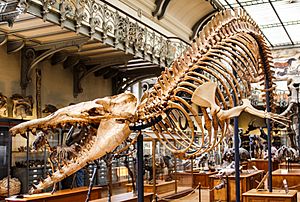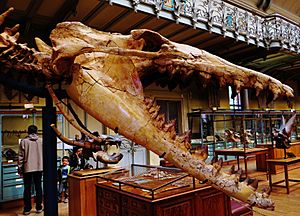Cynthiacetus facts for kids
Quick facts for kids Cynthiacetus |
|
|---|---|
 |
|
| Skeleton at the MNHN, Paris | |
| Scientific classification |
|
| Kingdom: | Animalia |
| Phylum: | Chordata |
| Class: | Mammalia |
| Order: | Artiodactyla |
| Infraorder: | Cetacea |
| Family: | †Basilosauridae |
| Subfamily: | †Dorudontinae |
| Genus: | †Cynthiacetus |
| Species | |
|
|
Cynthiacetus was an ancient type of whale that is now extinct. It lived a very long time ago, during a period called the Late Eocene epoch. This was about 40.4 to 33.9 million years ago! Scientists have found fossils of Cynthiacetus in places like the southeastern United States and Peru. It belongs to a group of early whales called basilosaurids.
What Was Cynthiacetus Like?

Cynthiacetus was named after a town called Cynthia in Mississippi. This is where the first important fossil of its kind, named C. maxwelli, was found.
Size and Body
The skull of Cynthiacetus looked a lot like the skull of another ancient whale called Basilosaurus. However, Cynthiacetus was different because its backbones (called vertebrae) were not as long as those of Basilosaurus. This means Cynthiacetus was a bit shorter and more compact.
Scientists also know that Cynthiacetus was smaller than another ancient whale named Masracetus.
Types of Cynthiacetus
There are two main types, or species, of Cynthiacetus that scientists have found:
- C. maxwelli: This is the first type discovered in the United States.
- C. peruvianus: This type was found in South America, specifically in Peru. It was the first early whale fossil ever found on that continent!
The C. peruvianus species is a bit different from C. maxwelli. It has a different number of small points (cuspids) on its lower teeth. It also had more bones in its upper back (thoracic vertebrae), with 20 of them. A full-grown C. peruvianus could be about 9 meters (about 30 feet) long!
See also
 In Spanish: Cynthiacetus para niños
In Spanish: Cynthiacetus para niños

